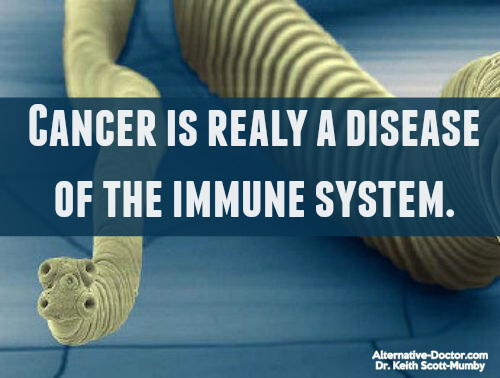Late last year (November) I came across a very strange report. The story itself is fairly fascinating but the implications are even more so.
Imagine cancer being transferred from a parasite to the human body! In this case the man had HIV (a whole argument in itself, whether that has anything to do with AIDS). The point being that this may potentially happen a lot—but that a competent immune system will suppress it, before anything bad ever happens.
See, this is a whole model of cancer; it’s called the “surveillance model”, meaning the immune system is constantly scanning for rogue cells and pathogens and will destroy whatever it finds, before there’s even a problem.
That’s why you will remember me writing often that cancer is really a disease of the immune system (kidney cancer is a disease of the immune system; lung cancer is a disease of the immune system; cervical cancer is a disease of the immune system; and so on…)
In this case we may suppose the HIV positive man was not being protected properly by his immune system.
Well, he got cancer. It appears to have come from a transfer by a tapeworm known as Hymenolepis nana, or the dwarf tapeworm—the most common human tapeworm worldwide, particularly in developing nations. At any given time, up to 75 million people carry it, according to the U.S. Centers for Disease Control and Prevention.
 The grotesque cancer-carrier Hymenolepis nana
The grotesque cancer-carrier Hymenolepis nana
This has scientists reeling. It’s the first known case of what’s now being called “malignant transformation”. It’s pretty scary.
As you will know, if you have read my Parasites Handbook, parasites are so common that virtually everybody has, or has had, one or two. In fact the opening words in that book are as follows:
Parasites are bad news for us. In their award-winning documentary program, The Body Snatchers, National Geographic reported, “Parasites have killed more humans than all the wars in history.” [Season 1, episode 17]
Parasites are probably the most diverse of all biological forms and yet by definition remain implacably hostile to humans. Of the 7.8 billion acres of potential arable land on Earth, only 3.4 billion acres can be farmed; most of the rest cannot be developed because of parasites (malaria, trypanosomiasis, schistosomiasis and onchocerciasis).
That’s less than half the Earth’s farmable land available to us, because of these critters, at a time when humans need food resources like never before.
In Africa alone, an area the size of the USA cannot be farmed because of trypanosomes…
Now we have more reason to worry.
Note that in the rest of Living Creation, carriers do similar strange things. There is no reason we won’t find it happens a lot in humans too: viruses can transfer DNA material from one bacteria to another (including transferring antibiotic resistance); parasites can attract their target host by strange and devious means; Schistosoma haematobium is a parasite found in the water of some countries in the Middle East, Africa, and Asia and has been linked to bladder cancer; and prions certainly get around, though they are not even (really) alive!
We know that viral infections can cause cancer. Dennis Burkitt first discovered that about what is now known as Burkitt’s lymphoma. Since then we have found that hepatitis B and C can lead to liver cancer, HPV (human papillomavirus) can cause cervical cancer. Certain liver flukes have been linked to an increased risk of developing cancers of the bladder and bile ducts.
 Burkitt’s lymphoma on the left side of the face
Burkitt’s lymphoma on the left side of the face
Researchers don’t know the precise mechanisms behind these infection-cancer links, though.
A good friend of mine, Dr. Patrick Kingsley (retired), thinks there may come a time when we know that virtually all cancers are infectious in origin. Viruses are particularly apt to do it because they are basically foreign DNA (“bad news wrapped in protein”, as one medical wit put it). Unusual DNA is what cancer cells are all about. So there is a logical link.
A New Strange Disease
In 2013, doctors in Colombia asked the CDC to help diagnose bizarre biopsies from lung tumors and lymph nodes of a 41-year-old man who was HIV positive. The tumors looked similar to a human cancer, but initial CDC lab studies revealed the cancer-like cells were not human. That revelation kicked off a nearly three-year hunt for the cause of the man’s illness.
DNA testing finally revealed DNA from H. nana tapeworms in the man’s tumor in mid-2013. Unfortunately, the man died 72 hours later.
Some 3,000 kinds of tapeworms are known to infect animals. But H. nana is the only one that can complete its entire lifecycle from egg to adult tapeworm within an individual’s small intestine. This can lead to large numbers of H. nana in the intestine, especially in people with weakened immune systems whose bodies have a harder time fighting the parasite. Researchers theorize that the mechanism that allows parasites like H. nana to avoid human immune systems may also have allowed the tapeworm’s cells to proliferate unchecked in the Colombian man.
It’s not clear how or why the tapeworm cells became malignant and ultimately caused tumors in their human host.
My main point here is that you don’t have to be HIV positive to have a weakened immune system: just eat burgers, drink sugary sodas, pizzas and ice cream! The synthetic diet (manufactured food only) consumed by billions of people today is so deficient in nutrients, you cannot hope to build and maintain a viable immune system on it.
The link again, for my presentation at the Ultimate Health Symposium on Saturday: Click here for all the details. Don’t miss it!
SOURCES: Atis Muehlenbachs, M.D., Ph.D., medical officer, U.S. Centers for Disease Control and Prevention, Atlanta; Len Lichtenfeld, M.D., deputy chief medical officer, American Cancer Society, Atlanta; Nov. 5, 2015, New England Journal of Medicine
The post Can You Get Cancer By Tapeworms? Let’s Discuss Parasites and Cancer appeared first on Dr. Keith Scott-Mumby.
